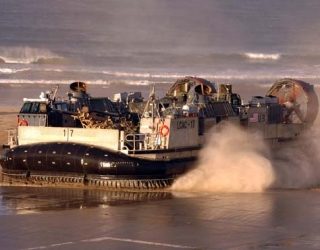Oct 24 2012
The US Navy's next-generation hovercraft will be powered by Rolls-Royce engines - the outcome of a contract presented to the power systems firm on 22 October 2012.
 Image depicts LCAC - copyright US Navy - courtesy Wikimedia Commons
Image depicts LCAC - copyright US Navy - courtesy Wikimedia Commons
These Rolls-Royce engines will equip the SSC (Ship-to-Shore Connector) platforms that will be manufactured by Textron Marine & Land Systems and enter US Navy service in around 2019.
Once operational, the SSCs will take over from the LCAC (Landing Craft Air Cushion) hovercraft in present day US Navy service and they'll be used to quickly ferry US Naval personnel and equipment from ships to shores.
Rolls-Royce SSC Contract
As a result of the 22 October Rolls-Royce SSC contract, the Ship-to-Shore hovercraft will be powered by the company's hi-tech MT7 gas turbines, developed from the popular AE1107 engines used in the MV-22B Osprey tiltrotor aircraft flown by the US Marine Corps.
The Landing Craft Air Cushion has equipped the US Navy since 1986 and it's also used by the JMSDF (Japanese Maritime Self-Defense Force). Gas turbine-powered, it's got a maximum speed of more than 70 knots and has a 300 mile range. Operated by a crew of five, the LCAS can transport up to 24 troops or a single Main Battle Tank, according to specific mission requirements.
US Navy SSC Hovercraft
The US Navy's SSC hovercraft will be an upgraded LCAS in some ways but will boast fly-by-wire systems, heavy use of composite materials and more powerful engines.
"This is an exciting and significant project for Rolls-Royce to be involved with", said Rolls-Royce's Naval President, Andrew Marsh. "Our gas turbine technology will increase the power of the hovercraft by 25 per cent, compared to the previous generation, enabling each craft to transport up to 74 tons of cargo at speeds over 35 knots. At the same time our engines will improve fuel efficiency by 11 per cent.
"We look forward to working with Textron and the Navy during the development and entry into service of these highly versatile craft."